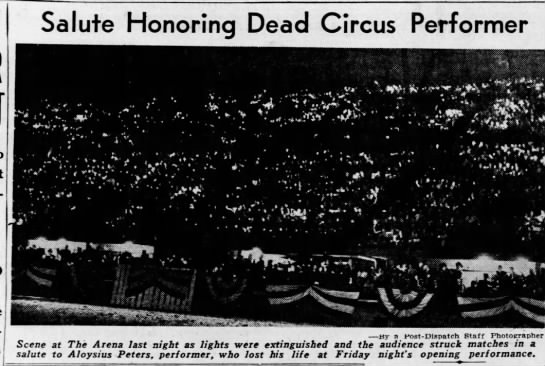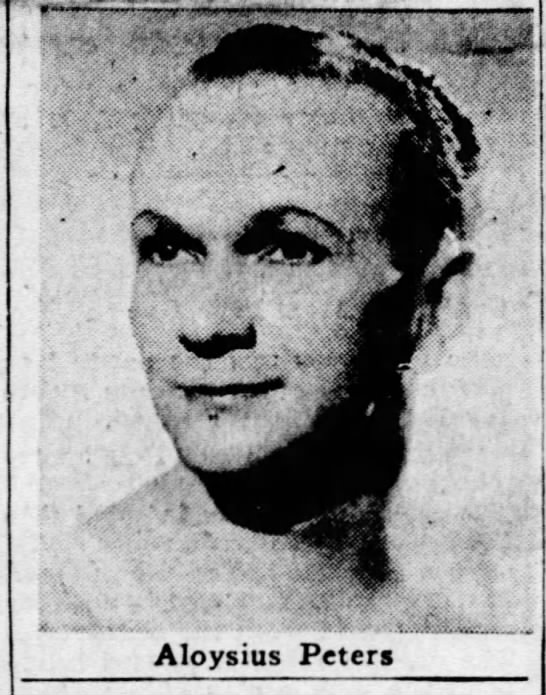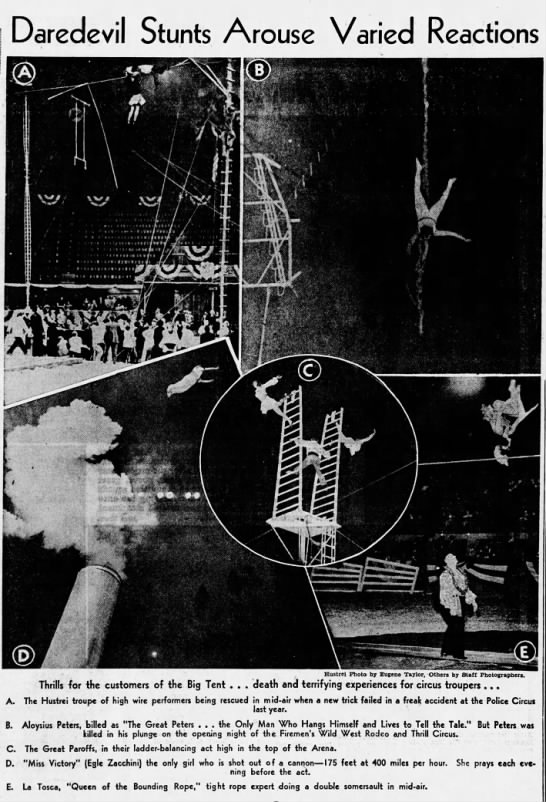

Ottawa, Ontario, Canada
22 Aug 1938, Mon • Page 15
I was looking for some information for someone on Friday when I came across this photo of The Great Peters who did a dazzling feat at the Ottawa Ex in August of 1938. I asked myself if he made it through life trying to hang himself daily, and somehow I just knew that he had screwed up somewhere.
None of them had expected to see a man actually die that night in St. Louis in October of 1943 at Tom Pack’s Police Circus tours. In spite of the announcement before The Great Peters act none of those almost 6,000 folks ever thought he might become the victim of the leap which he had performed hundreds of times.
Booked as “the man who hangs himself and lives to tell it,” Aloysius Peters, 45, was killed at the Arena, the victim of a leap from a defective rope. Peters climbed to the 75-foot trapeze bar for his act and, adjusting a noose around his neck, plummeted into space before 5,627 horrified spectators.

A veteran performer, who said his family had been in circus work for more than 500 years, was listed as No. 13 that night on the Firemen’s Wild West Rodeo and Thrill Circus. It was his death number as he climbed to the 75 – foot trapeze bar for his act and adjusted a noose around his neck before he plummeted into space.
Always before he had grabbed the rope a second or so before he hit the end of the jump, thus taking the jerk with his arms. That night he apparently reached for the rope to break the fall a split second too late and was hanged.

St. Louis, Missouri
24 Oct 1943, Sun • Page 3
The “rope” he used was not resilient enough, his wife said, and put his timing off. Made of strands of rubber covered with canvas, the rope was a new one which he purchased two weeks previous in Cleveland and the wartime rubber was not the same quality he previously had purchased from London. When he jumped that night the rope tightened under the impact of his weight, then jerked him 20 feet into the air to dangle like a sack until attendants brought his body down.
The performer was rushed to Deaconess Hospital but was pronounced dead before arrival. The police report said death was caused by a broken neck. Billed as “The Great Peters” the showman received, from $650 to $1,000 a week from his act, according to Jack Van Pelt, publicity director of the show. Fire Chief Egan Richter said that a check for approximately $800, a full week’s salary, would be sent to the widow.
Peters was adding a new thrill to his performance that night and was jumping 30 feet farther than before. Because of the longer distance, it is believed he failed to estimate the exact moment to grab the rope to keep the noose from his neck. For the first time his wife, the former Catherine Cowdery, failed to watch his performance. As an expectant mother, she had assisted with the act until two weeks ago. She remembered he worked with the rope all day on the kitchen floor, testing it again and again. He didn’t say anything about it not being up to standard or she would have insisted he use the old rope to make the usual jump.
The crowd had been warned by the announcer when Peters began his act that he required absolute quiet in order to concentrate fully. The arena was brilliantly lit as the figure in white-spangled tights started the headfirst dive which ended his life. Spectators were quiet until he reached the end of the rope, then they roared their approval, not realizing he had been fatally injured.
Members of the family described the rope as “one-half inch rubber rope”, and said it did not contain any steel cable or other metal. Perry held the ladder for Peters as he climbed to the 75-foot high platform for the finale of his act. “I have seen him jump many times, Perry said, “but he went so fast this time that I knew something was wrong. That new rope just didn’t have enough ‘give’ to it.”
Mrs. Peters was expecting the birth of her child the next day the newspapers said. She was taken to a hospital the night following the tragedy, but was resting at the home of an aunt and uncle the next day. When asked if she would permit her expected child to become a circus performer, Mrs. Peters replied, “No sir. After all the circus is not in my blood, and even though my child will have a heritage of several centuries on the paternal side, I will discourage any signs of showmanship. I don’t want my child to be a performer.”
Peters, who was born in Germany, came to the United States in 1931 and appeared with Tom Mix, the Ringling Brothers circus and Gene Autry. “My husband had been doing this act for almost 13 years,” Mrs. Peters said. “In Canada a few weeks ago he did a 165-foot jump, much longer than last night’s jump, and nothing happened. His family has been in the circus business since the year 1800. He always told me that everyone had a time to die and, no matter when it was, when his turn came, he would be ready to go. Every time one of his old circus friends met with a fatal accident he cautioned me to be ready if such a thing ever happened to him”.
“But I wasn’t ready,” she kept repeating. Mrs. Peters met her husband when he appeared with the Police Circus and they were married almost three years ago.
The huge crowd sat in hushed silence following the accident, at first unaware of the tragedy. When Peter’s body snapped into the air following the impact at the end of the jump the announcer told the crowd, “He’s dazed momentarily.” When the body continued to hang limp in mid-air, A. P. Seldon, one of the circus performers who is booked as “the man who swings and sways in the air,” climbed the ladder to remove the body. Fire Chief Egan-Richter directed the removal. It took over an hour to remove the body in a packed arena. Many customers walked out and some performers refused to perform after the incident.

Veteran circus performers stood by and wept unashamedly, but all went on with the show when their spots came. Tears streaming down her makeup, Genevieve Canistrellis declared the entire company considered Peters “a great performer.” Billy Pape said he had a premonition as he went on for his act that something might happen to Peters. Brightly dressed clowns, too, were crying backstage.
To make matters worse a dummy clown was shot out of a cannon later on in the evening, but none of the paying customers realized it when the dummy’s head hit the ceiling and was stuck between two girders.
Ernie Young, arena director, who said he had booked Peters for 10 years, asserted he was one of the top performers. Peters’ death wasn’t the only excitement provided the opening-night crowd. A wild Brahma bull bucked his rider off and leaped over the 5-foot-high side rail, scattering those in box seats into the ring or to standing positions on their, chairs. The animal charged through the aisle in back of the boxes, running halfway around the Arena before he was captured. The bull’s rider, Russell Bryan, 28, of 457A Eichelberger St., was taken to City Hospital where he was pronounced suffering from a possible fracture of the left forearm.
Cause of death? Aloysius Peters, known to fans as “the Great Peter” and “The Man Who Hangs Himself and Lives,” lost his life at Louis, Mo., Firemen’s Annual Benefit Show when the new rope used did not have sufficient elasticity to break his fall. Reality? Production of rubber, and plastics leaped during the war, nearly quadrupling so it went down in quality. That rope really was not appropriate fare for a death defying circus act of that magnitude.


St. Louis, Missouri
24 Oct 1943, Sun • Page 43

What is this show which, like a Roman carnival, horrifies the spectators with the drama of sudden death? It is billed as a Wild West rodeo and thrill show. It is a professional carnival enterprise, in this Instance bolstering its profits by sharing receipts with the firemen’s benefit fund. As worthy as is this fund, can the firemen of St. Louis afford to be longer associated with this kind of entertainment which so recklessly allows performers to expose themselves to danger, and the public to possible scenes of horror?

St. Louis, Missouri
05 Nov 1943, Fri • Page 20

The Ottawa Citizen
Ottawa, Ontario, Canada
20 Jul 1938, Wed • Page 19
n’ Mamas (USA) and The Sherbrooke Record

When the Circus Shut the Town Down
The Boy that Ran Away to the Circus and Other Stories
When the Circus came to Carleton Place
The Continuing Curse of William Street in Carleton Place
What Happened the Day the Circus Left Carleton Place
Just Beat It! Carnival Riot in Carleton Place at Riverside Park
The Horses of Carleton Place– Wonder if they ever had a Merlin?
